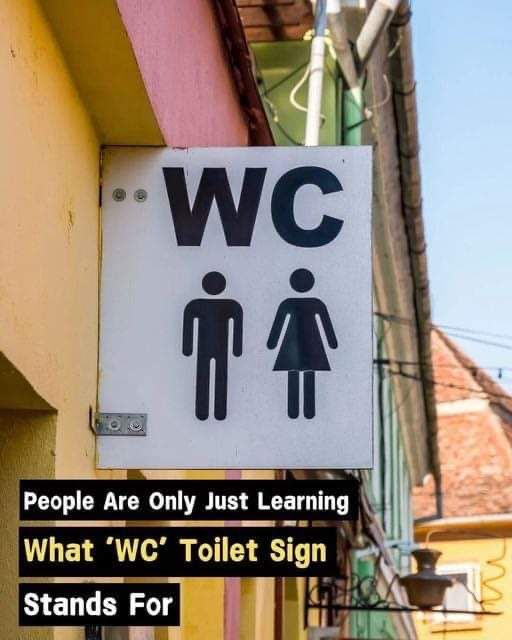Across the world, restrooms go by many different names—bathroom, restroom, lavatory, loo, toilet—but one term continues to pop up in hotels, public places, and travel destinations, leaving many Americans puzzled: the sign that reads “WC.” While it might look official or even vaguely medical, plenty of people have no idea what those two simple letters stand for. Recently, a TikTok video went viral for explaining the meaning behind “WC,” and the surprising history behind the abbreviation left viewers both shocked and intrigued. As it turns out, “WC” stands for “water closet,” a term that originated back in the 1870s and referred to an early version of the modern indoor toilet.

The phrase “water closet” might sound strange to modern ears, but it made perfect sense in the late 19th century. At the time, indoor plumbing was just starting to become more common, and the idea of having a flushing toilet inside a home or building was considered a major innovation. Because bathrooms were often tucked away in tight, closet-like spaces, the term “water closet” emerged to describe a small room where water was used to flush waste away. As the technology evolved and spread throughout Europe, the phrase was eventually shortened to “WC,” making it easier to fit on signs and architectural plans. Over time, the abbreviation became the go-to label for public restrooms, especially across Europe and in parts of Asia.
While “WC” is a well-known term in many parts of the world, particularly in Europe, it hasn’t quite caught on in the U.S., which is why so many Americans were surprised by the TikTok explanation. The video sparked a wave of online discussion, with many users admitting they had seen “WC” signs in airports, hotels, or while traveling abroad, but never knew what they meant. Some had assumed it was an abbreviation in another language, while others never stopped to think about it at all. The discovery led to a collective “aha” moment for many people, turning a small piece of historical trivia into a trending topic on social media.
What makes “WC” so interesting is that, even though the full term “water closet” is rarely used today, the abbreviation has stood the test of time. In modern conversation, especially in the U.S., most people say “restroom” in public or “bathroom” at home, even if there’s no bathtub involved. Meanwhile, in the U.K., people often say “loo,” and Australians typically use the word “toilet.” Despite all these variations, the “WC” sign has managed to remain a universal symbol for a bathroom, especially in places catering to international travelers. You’ll often find it in airports, train stations, old hotels, and European cafés, where the simple letters “WC” on a door quietly direct visitors to the nearest toilet.
@hullsome Basically every country uses WC to mark a bathroom. I didn’t know what WC meant for the LONGEST TIME. Talk about a conundrum, make sure you have some spare change too! #Bathroom #WC #America #American #European #Europe #Restroom #WaterCloset ♬ Hell To Da Naw Naw Naw – Bishop Bullwinkle
Interestingly, even architects and designers continue to use “WC” on blueprints and floor plans. The abbreviation is practical, concise, and universally understood among professionals, which makes it easier to use across different languages and cultures. It also brings a certain classic charm to older buildings and establishments that want to maintain a traditional European feel. Some upscale or vintage-style hotels even use “WC” on signs to give their restrooms an old-world aesthetic.
The story behind the WC sign is a reminder of how language, culture, and technology evolve together. What started as a literal description of a small, water-equipped room has now become a symbol understood worldwide, even if many people no longer know what it stands for. It’s also a great example of how some terms, no matter how outdated they may seem, stick around because they continue to serve a purpose.
So next time you’re in a foreign airport, an old hotel, or even a trendy café and you spot the letters “WC” on a door, you’ll know exactly what they mean—and the surprising bit of history behind them. A term born in the age of Victorian innovation still quietly lives on today, helping people from all walks of life find the nearest toilet, one small sign at a time.





